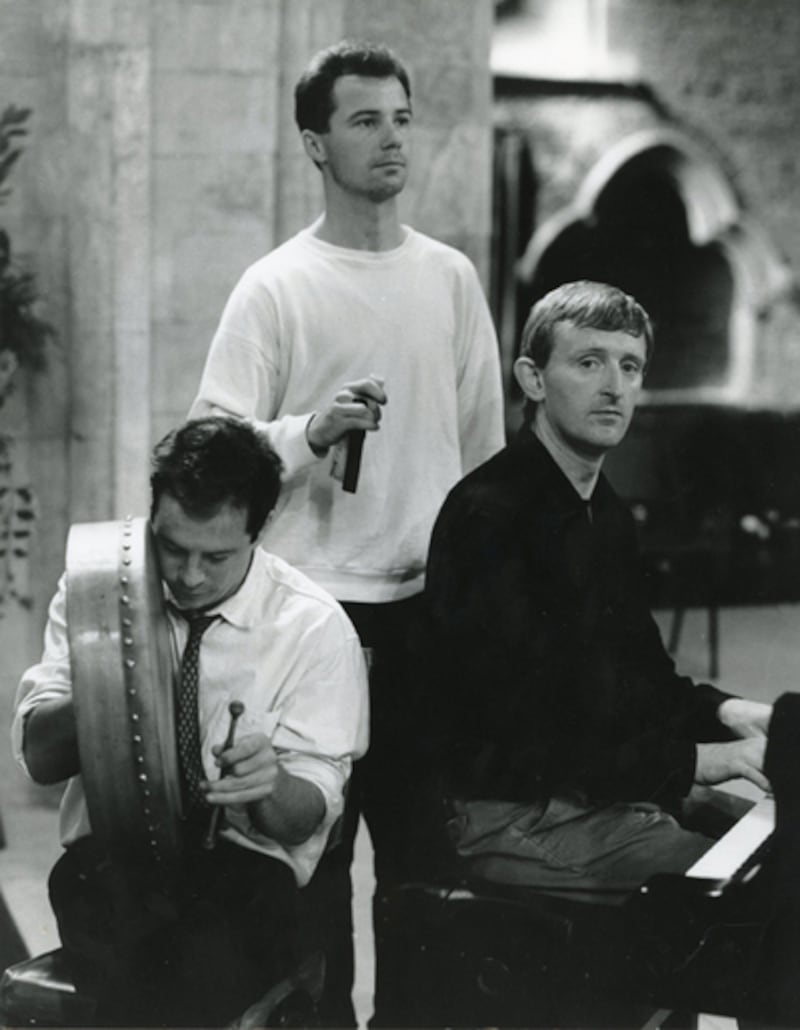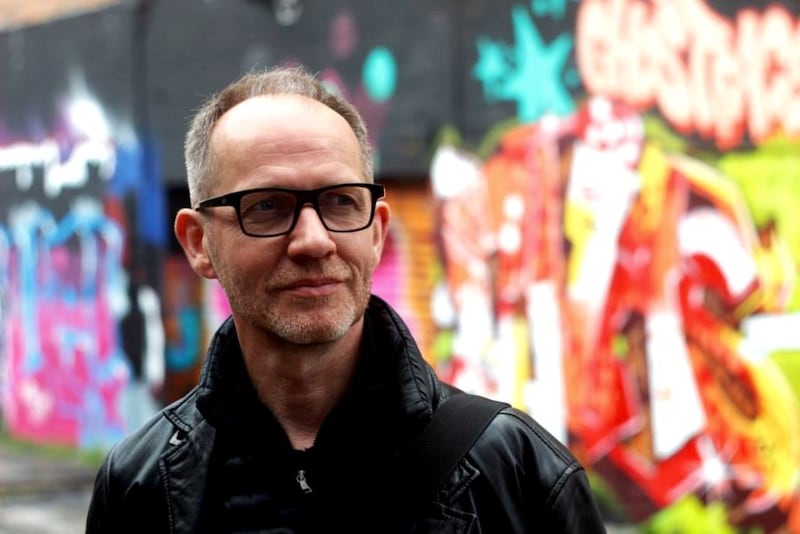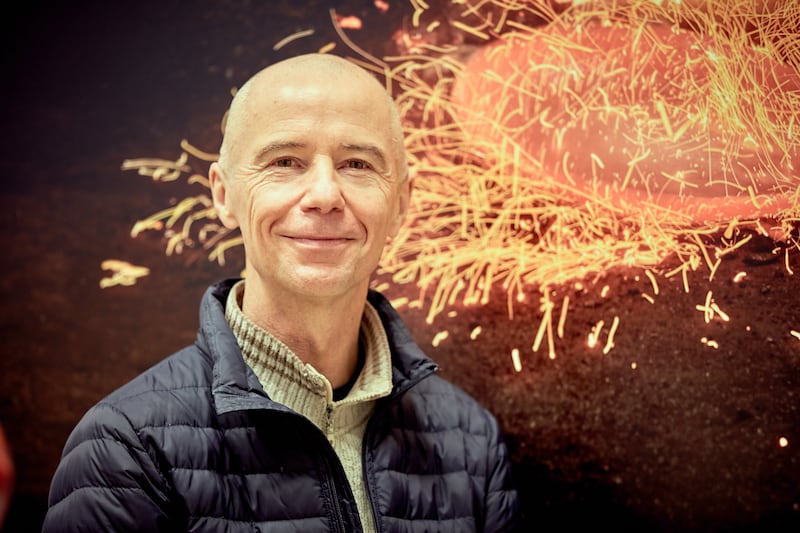“How can we live well with each other?” Helen Phelan, newly appointed director of the Irish World Academy of Music and Dance at the University of Limerick, and widow of Micheál Ó Suilleabháin, is describing her late husband’s philosophy of life. ‘He embodied the space between worlds: musical and cultural worlds and he invited so many conversations between those different worlds. In all of those aspects of his work: musical, academic, cultural, he saw life as a crossroads. Many people come in order to pass through it. But Micheál felt that for him it was important to arrive at a crossroads and stay there, and somehow to hold the tension in himself and his music and the tension of the meeting point, and that is a core legacy.”
The force of nature that was Micheál Ó Suilleabháin transformed our understanding of our own traditional arts, as well as our ability to relate them to the wider musical world. Before his death, Ó Suilleabháin had performed two concerts in a planned trilogy with the National Symphony Orchestra in the National Concert Hall: Elver Gleams in 2017 and Between Worlds in 2018. The third and final concert, Lumen: A Celebration of the Light, will take place in the National Concert Hall on September 2nd and in the University of Limerick on September 3rd, and will feature some of Ó Suilleabháin’s most significant orchestral works conducted by David Brophy and performed by a swathe of leading musicians including sean-nós singer Iarla Ó Lionáird, percussionist Mel Mercier and flute player and piper Micheál McGoldrick. The National Concert Hall will also present their Lifetime Achievement Award to Micheál posthumously on September 2nd.
“Michael believed in communication, whether that was through music or through spoken language,” Phelan says, recalling the qualities that propelled Ó Suilleabháin towards his ultimate vision for music in Ireland. “It was always an invitation to dialogue, to an encounter with something beyond yourself.”

The intense creativity that characterised his lengthy career continued right up to the end of his life. As well as founding the Irish World Academy in UL, Ó Suilleabháin devised and wrote the groundbreaking RTÉ/BBC TV series, A River of Sound in 1995, and his voice was never far from any spirited debate on the role and place of traditional arts in Irish life and in the wider world. The chutzpah inherent in the title chosen for his new centre of performing arts in UL, the Irish World Academy, speaks volumes in this regard. Micheál Ó Suilleabháin strode across the world, planting ideas that were landmines to be exploded, widening his students’ perceptions and challenging audiences to think again, to listen more closely, to play with renewed vigour.
Fionnula Flanagan: I remember the ‘No Irish or dogs’ signs. I didn’t want to live in a country that took that attitude towards me
David McWilliams: Ireland needs a mindset shift from what is impossible to what is possible
Looking forward to a future where doctors prescribe time to take in a hedgerow
Is Guinness owner Diageo on activist investors’ radar as stock languishes at eight-year low?
“Micheál had all the obvious qualities: energy, charisma, intelligence, creativity,” Phelan notes. “But there were two things: he knew it was a long game, requiring sustained commitment, and something else, more in the realm of the ethical. He had a deep integrity, a deep respect for other cultures. It was rooted in his soul, in his own encounters with music, whether that was the Beatles or Tommy Potts.”
Micheál’s health was in peril in his final years and, true to form, he prepared impeccably for his own departure, in musical terms.

“He was writing himself out of the music,” Phelan says. “It was a conscious decision. When he played, his own music was very much anchored in traditional repertoire, but he developed what I would call a late style, much as Edward Said wrote about in his book On Late Style.
“It’s not to do with age, but with life cycle. There’s a point in the life cycle, where there’s this magic alchemy where all of the learning from the previous stages of your life cycle can coalesce. It resonated deeply with Micheál, because he understood that at certain points in your life, you can experience great bursts of freedom and I think there was a freedom in retiring from UL, from a public service role, and he blossomed in that phase for sure.”
Michael McGoldrick is a piper and flute player with a long association with Ó Suilleabháin. Speaking from L’Orient, he recounts his memories of a man who left a deep impression on him.
“Micheál was moulding contemporary classical music and contemporary jazz with traditional music together and breaking down barriers,” McGoldrick recalls. “I thought the man had a brilliant vision. I think he felt traditional music should engage with the classical world because, up to then, we hadn’t really heard anything like the orchestration that was in Micheál’s records. Now, I’m here rehearsing with the Breton Symphony Orchestra, playing Capercaille’s music with orchestral arrangements. Thanks to what he was doing 20 years ago, he helped create what we’re doing right now. He was the man who had that imagination to bring the different musical forms together, without any snobbery. Music is music. If we speak a language together, we can make beautiful things.”

Iarla Ó Lionáird is a singer known for his extraordinary voice and the inimitable way in which he inhabits sean nós songs. He regularly collaborated with Ó Suilleabháin.
“He had this extraordinary cartographer’s perspective on our music”, Iarla suggests. “He knew where all the secret idiomatic language lay. He knew the very fine detail of local accent and indicators of place, of history, of memory, within the great melodies of the Munster sean nós tradition. When he would do introductions to songs, he would lay out the map in front of you, like an invitation to roam. As if he was handing you the stick, to show you where the path was. He just knew the music so profoundly.
“At other times, he’d take a more tangential approach. For example he laid down an Indian ragga for An Buachaill Caol Dubh, a song about addiction and failure, which would rise up inside it. Looking back, the notion of the relationships between great continents of music appealed to him. Seán Ó Riada had promulgated some of those notional relationships and others too, such as [film-maker] Bob Quinn. Micheál had extraordinary powers because of his musicianship and his knowledge, which made his choices very rich, and that was like a magic carpet for me.”
Mel Mercier is the chair of the Irish World Academy, a percussionist and much-lauded composer who has known and worked with Ó Suilleabháin since their first encounter in 1974, when Mel was just 14 and Ó Suilleabháin was in his early 20s. They were contributing music to Tony MacMahon’s radio series, The Long Note.

“He was full of energy and full of good humour,” Mercier says. “He was bursting with energy, with musical ideas and with creativity. There was something about those two sides of him: the traditional musician on the one hand, and the classical musician on the other, and a sense of them coalescing and of sparking off each other: a kind of electricity about it. And that was a conversation he continued for the rest of his life, and I think that that interface was where his spark was at its brightest. He had that highly original piano style and he could always find space in between and within tunes. And I think he achieved it best on the Dolphin’s Way album.”
Mercier followed Ó Suilleabháin’s footsteps, first in UCC and later in UL where he is chair of performing arts at the Irish World Academy. The pair’s live performances were a joy to behold, with each bouncing off the other in a delirious helix of complex rhythms and magnificent tunes. Their “Must be More Crispy” duet never fails to tease listeners with its inherent playfulness and wicked sense of humour.
“Micheál always liked to leave space for others,” Mercier recalls. “His move to UL turned out to be the best thing for music education in Ireland and specifically for traditional Irish music. One of his great legacies is that he cultivated and nurtured very fertile educational and cultural spaces in Cork and in UL. When he moved on from those spaces, the people who stepped in had the opportunity to blossom and grow themselves.”
Mercier still feels a deep sense of loss at Ó Suilleabháin’s passing.
“One of the things I’ve had to come to terms with is the fact that I’ll never play with Micheál again,” he says. “That duet was one of the pillars of my musical life, and my relationship with him was at its centre, as a colleague, a musician and a friend. But the music making now is somewhere else, in the body memory. I’ll never sit again in that privileged space, the well of his piano, with the sound of Micheál wrapped around me. It was a feeling of his sound moving through me and out into the audience. So that’s a big personal loss for me. That was a very rich space, full of fun and full of creativity and devilment.”
Lumen: A Celebration of the Light is at the National Concert Hall on September 2nd and the University of Limerick on September 3rd















